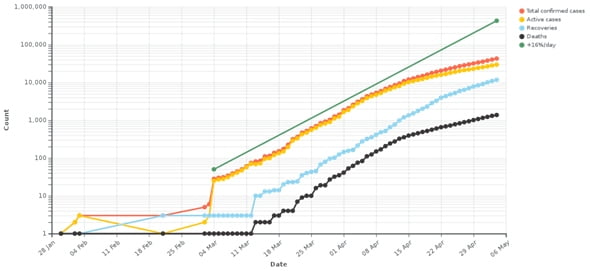The coronavirus pandemic, COVID-19 (known as SARS-CoV-2 in medical parlance), has caused havoc across the world, bringing nations to a lockdown of unseen proportions. In all the affected places, there have been unprecedented implications on the work-life balance: the office, industry, business, governance, agriculture, science, educational institutes etc.; with the only overactive sector being the medical and allied sector. Perforce, we have resorted to the blessings of online digital platforms, from the conduct of academic classes to the entire gamut of keeping supply chains alive. All travel means have come to a grinding halt, with all the international/ domestic sports activities being suspended or cancelled.
Going by latest on May 4 afternoon, the virus has spread to 210 countries and has claimed the lives of 2,48,286 people; with the total number of affected cases being 35,66,294. The confirmed cases in India are 42,548 with the death toll rising to 1391. India began its lockdown from March 24 and continued through May 3, only to re-enter another lockdown phase 3.0 for another two weeks in continuum. The Centre has stratified three clear zones of containment as Red, Orange and Green depending upon the severity, contamination history and the expected ingress of habitants; with clear tabular layout of social activities in permit or without it.
Lockdown Decision and the Interpretive Data
India reported its first case on January 30 and in keeping with directives from the World Health Organisation (WHO) and the Union Government’s Task Force set up to tackle the pandemic, India went in for various stages of the lockdown as follows:
March 22: 14-hour voluntary public ‘Janata Curfew’
Phase 1: March 25 – April 14
Phase 2: April 15 –May 3
Phase 3: May 4 – present (scheduled to end on May 17)
The world saw the largest-ever national lockdown in the COVID-19 lockdown in India. India was quick to close its international borders and enforce an immediate lockdown, which WHO praised as “tough and timely”. The lockdown has also given the government time to prepare for a possible surge in cases when the pandemic is forecasted to peak in the coming weeks. Still, India’s population of 1.3 billion across diverse states, health inequalities, widening economic and social disparities, and distinct cultural values present unique challenges.

Table 1: Plot of the spread of SARS-CoV-2 and of COVID-19 deaths in India. An exponential growth rate of a 16% increase in cases per day is shown.
Graph source: Data from MoHFW

Table 2: New and Cumulative Cases and the Doubling Rate: COVID-19-India Courtsey:www.indiatoday.in
The projection shows a trend that moves in the downward curve to zero till May 16.
“Decision of lockdown was timely, the curve has begun to flatten. The nation has shown that lockdown has been effective, saving lives, containing COVID-19 infection and slowing down doubling rate. We need to build on these gains. We have also seen projections tell us that it may reach 14 days in coming time,” said Dr VK Paul, a retired professor at AIIMS, Delhi, and member (Health) at Niti Aayog.
The Oxford COVID-19 Government Response Tracker (OxCGRT), in its report based on data from 73 countries, says the Indian Government has responded more stringently than other countries in tackling the pandemic. It noted the government’s swift action, emergency policy making emergency investment in healthcare, fiscal measures, investment in vaccine research and active response to the situation, and scored India with a “100” for its strictness.


